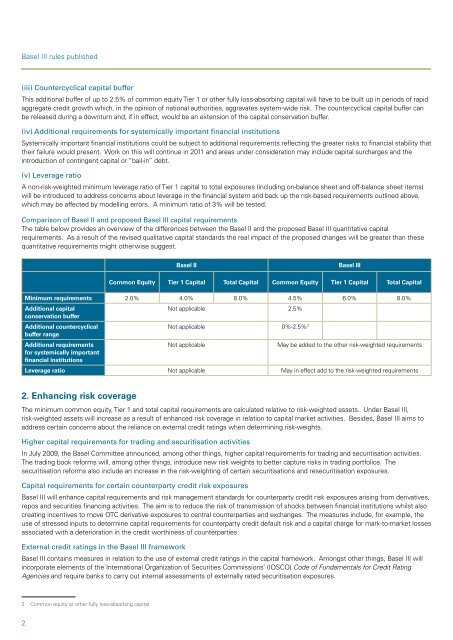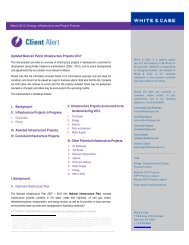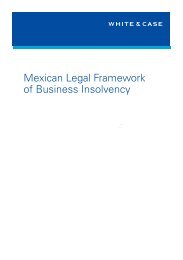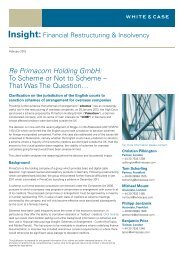Basel III rules published - White & Case
Basel III rules published - White & Case
Basel III rules published - White & Case
You also want an ePaper? Increase the reach of your titles
YUMPU automatically turns print PDFs into web optimized ePapers that Google loves.
<strong>Basel</strong> <strong>III</strong> <strong>rules</strong> <strong>published</strong><br />
(iii) Countercyclical capital buffer<br />
This additional buffer of up to 2.5% of common equity Tier 1 or other fully loss-absorbing capital will have to be built up in periods of rapid<br />
aggregate credit growth which, in the opinion of national authorities, aggravates system-wide risk. The countercyclical capital buffer can<br />
be released during a downturn and, if in effect, would be an extension of the capital conservation buffer.<br />
(iv) Additional requirements for systemically important financial institutions<br />
Systemically important financial institutions could be subject to additional requirements reflecting the greater risks to financial stability that<br />
their failure would present. Work on this will continue in 2011 and areas under consideration may include capital surcharges and the<br />
introduction of contingent capital or “bail-in” debt.<br />
(v) Leverage ratio<br />
A non-risk-weighted minimum leverage ratio of Tier 1 capital to total exposures (including on-balance sheet and off-balance sheet items)<br />
will be introduced to address concerns about leverage in the financial system and back up the risk-based requirements outlined above,<br />
which may be affected by modelling errors. A minimum ratio of 3% will be tested.<br />
Comparison of <strong>Basel</strong> II and proposed <strong>Basel</strong> <strong>III</strong> capital requirements<br />
The table below provides an overview of the differences between the <strong>Basel</strong> II and the proposed <strong>Basel</strong> <strong>III</strong> quantitative capital<br />
requirements. As a result of the revised qualitative capital standards the real impact of the proposed changes will be greater than these<br />
quantitative requirements might otherwise suggest.<br />
2. Enhancing risk coverage<br />
The minimum common equity, Tier 1 and total capital requirements are calculated relative to risk-weighted assets. Under <strong>Basel</strong> <strong>III</strong>,<br />
risk-weighted assets will increase as a result of enhanced risk coverage in relation to capital market activities. Besides, <strong>Basel</strong> <strong>III</strong> aims to<br />
address certain concerns about the reliance on external credit ratings when determining risk-weights.<br />
Higher capital requirements for trading and securitisation activities<br />
In July 2009, the <strong>Basel</strong> Committee announced, among other things, higher capital requirements for trading and securitisation activities.<br />
The trading book reforms will, among other things, introduce new risk weights to better capture risks in trading portfolios. The<br />
securitisation reforms also include an increase in the risk-weighting of certain securitisations and resecuritisation exposures.<br />
Capital requirements for certain counterparty credit risk exposures<br />
<strong>Basel</strong> <strong>III</strong> will enhance capital requirements and risk management standards for counterparty credit risk exposures arising from derivatives,<br />
repos and securities financing activities. The aim is to reduce the risk of transmission of shocks between financial institutions whilst also<br />
creating incentives to move OTC derivative exposures to central counterparties and exchanges. The measures include, for example, the<br />
use of stressed inputs to determine capital requirements for counterparty credit default risk and a capital charge for mark-to-market losses<br />
associated with a deterioration in the credit worthiness of counterparties.<br />
External credit ratings in the <strong>Basel</strong> <strong>III</strong> framework<br />
<strong>Basel</strong> <strong>III</strong> contains measures in relation to the use of external credit ratings in the capital framework. Amongst other things, <strong>Basel</strong> <strong>III</strong> will<br />
incorporate elements of the International Organization of Securities Commissions’ (IOSCO) Code of Fundamentals for Credit Rating<br />
Agencies and require banks to carry out internal assessments of externally rated securitisation exposures.<br />
2<br />
<strong>Basel</strong> II <strong>Basel</strong> <strong>III</strong><br />
Common Equity Tier 1 Capital Total Capital Common Equity Tier 1 Capital Total Capital<br />
Minimum requirements 2.0% 4.0% 8.0% 4.5% 6.0% 8.0%<br />
Additional capital<br />
conservation buffer<br />
Not applicable 2.5%<br />
Additional countercyclical<br />
buffer range<br />
Not applicable 0%-2.5% 2<br />
Additional requirements<br />
for systemically important<br />
financial institutions<br />
Not applicable May be added to the other risk-weighted requirements<br />
Leverage ratio Not applicable May in effect add to the risk-weighted requirements<br />
2 Common equity or other fully loss-absorbing capital
















